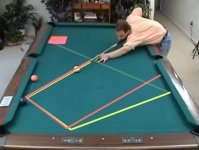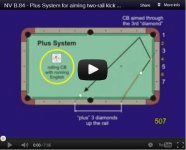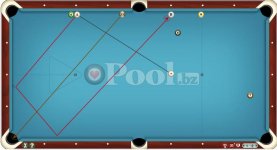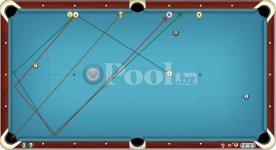I don't know of a system, but I have some tricks to estimate it.
I think straight inside spin (no top) is a bit more predictable than high+inside. Both can get the job done, when you add topspin to the mix, the cue ball hooks and doesn't turn as sharply off the first rail. It's hard to predict how much the spin will take off each rail and how sharply it will 'bend'.
If you use just middle sidespin, imo not only moves the ball around more easily, the path starts to look more like a typical 2-rail kick path. It becomes semi-predictable. So I'd first recommend practicing this with just plain middle sidespin. Maybe just a smidge of top.
My trick for this is to understand the maximum effect you can get from inside spin, which is to make the cue ball's path from rail 2 to 3... run almost parallel to the path from cue ball to object ball.
You need a ton of inside spin to even come close to this imaginary line.
So you know a more realistic line will have you hit the third rail quite a bit south of the imaginary maximum line. How far south? Well in the video, it's a little over 1 diamond, which I think is a good rule of thumb for common angles like 30-45 degrees.
Finally, when the cue ball arrives at the head of the table, it will be almost a perfect mirror-like reflection of the path going into the third rail, because most of the speed and spin has died down and it's mostly just a naturally rolling ball now.
I'm trying to draw what I mean in the attached diagram. Basically:
1. I imagine where I am hitting the first rail with "average inside" which varies from player to player and cue to cue

2. I imagine the "maximum inside" line (shown in pink)
3. I imagine the object ball realistically hitting the third rail at least a diamond below that line (shown in yellow)
4. By imagining [1] and [3] I can sort of visualize the line coming into the third rail, and I assume the line exiting the third rail is pretty much a mirror-like reflection of it. In other words, if it's moving at 45 degrees and hits a diamond below the side, it will end up on the 4th rail about a diamond below the corner.



